Mode of Action of GH30-7 Reducing-End Xylose-Releasing Exoxylanase A (Xyn30A) from the Filamentous Fungus Talaromyces cellulolyticus
- PMID: 31003983
- PMCID: PMC6581162
- DOI: 10.1128/AEM.00552-19
Mode of Action of GH30-7 Reducing-End Xylose-Releasing Exoxylanase A (Xyn30A) from the Filamentous Fungus Talaromyces cellulolyticus
Abstract
In this study, we characterized the mode of action of reducing-end xylose-releasing exoxylanase (Rex), which belongs to the glycoside hydrolase family 30-7 (GH30-7). GH30-7 Rex, isolated from the cellulolytic fungus Talaromyces cellulolyticus (Xyn30A), exists as a dimer. The purified Xyn30A released xylose from linear xylooligosaccharides (XOSs) 3 to 6 xylose units in length with similar kinetic constants. Hydrolysis of branched, borohydride-reduced, and p-nitrophenyl XOSs clarified that Xyn30A possesses a Rex activity. 1H nuclear magnetic resonance (1H NMR) analysis of xylotriose hydrolysate indicated that Xyn30A degraded XOSs via a retaining mechanism and without recognizing an anomeric structure at the reducing end. Hydrolysis of xylan by Xyn30A revealed that the enzyme continuously liberated both xylose and two types of acidic XOSs: 22-(4-O-methyl-α-d-glucuronyl)-xylotriose (MeGlcA2Xyl3) and 22-(MeGlcA)-xylobiose (MeGlcA2Xyl2). These acidic products were also detected during hydrolysis using a mixture of MeGlcA2Xyl n (n = 2 to 14) as the substrate. This indicates that Xyn30A can release MeGlcA2Xyl n (n = 2 and 3) in an exo manner. Comparison of subsites in Xyn30A and GH30-7 glucuronoxylanase using homology modeling suggested that the binding of the reducing-end residue at subsite +2 was partially prevented by a Gln residue conserved in GH30-7 Rex; additionally, the Arg residue at subsite -2b, which is conserved in glucuronoxylanase, was not found in Xyn30A. Our results lead us to propose that GH30-7 Rex plays a complementary role in hydrolysis of xylan by fungal cellulolytic systems.IMPORTANCE Endo- and exo-type xylanases depolymerize xylan and play crucial roles in the assimilation of xylan in bacteria and fungi. Exoxylanases release xylose from the reducing or nonreducing ends of xylooligosaccharides; this is generated by the activity of endoxylanases. β-Xylosidase, which hydrolyzes xylose residues on the nonreducing end of a substrate, is well studied. However, the function of reducing-end xylose-releasing exoxylanases (Rex), especially in fungal cellulolytic systems, remains unclear. This study revealed the mode of xylan hydrolysis by Rex from the cellulolytic fungus Talaromyces cellulolyticus (Xyn30A), which belongs to the glycoside hydrolase family 30-7 (GH30-7). A conserved residue related to Rex activity is found in the substrate-binding site of Xyn30A. These findings will enhance our understanding of the function of GH30-7 Rex in the cooperative hydrolysis of xylan by fungal enzymes.
Keywords: Talaromyces cellulolyticus; exoxylanase; glycoside hydrolase family 30; lignocellulose; xylan; xylooligosaccharide.
Copyright © 2019 American Society for Microbiology.
Figures
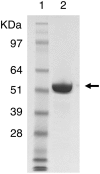
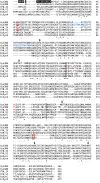

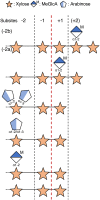
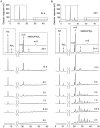
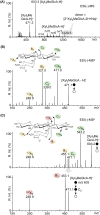

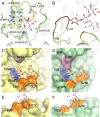
Similar articles
-
Crystal structure of GH30-7 endoxylanase C from the filamentous fungus Talaromyces cellulolyticus.Acta Crystallogr F Struct Biol Commun. 2020 Aug 1;76(Pt 8):341-349. doi: 10.1107/S2053230X20009024. Epub 2020 Jul 28. Acta Crystallogr F Struct Biol Commun. 2020. PMID: 32744245 Free PMC article.
-
GH30-7 Endoxylanase C from the Filamentous Fungus Talaromyces cellulolyticus.Appl Environ Microbiol. 2019 Oct 30;85(22):e01442-19. doi: 10.1128/AEM.01442-19. Print 2019 Nov 15. Appl Environ Microbiol. 2019. PMID: 31492671 Free PMC article.
-
Structural and functional characterization of a bifunctional GH30-7 xylanase B from the filamentous fungus Talaromyces cellulolyticus.J Biol Chem. 2019 Mar 15;294(11):4065-4078. doi: 10.1074/jbc.RA118.007207. Epub 2019 Jan 17. J Biol Chem. 2019. PMID: 30655295 Free PMC article.
-
Xylanases of glycoside hydrolase family 30 - An overview.Biotechnol Adv. 2021 Mar-Apr;47:107704. doi: 10.1016/j.biotechadv.2021.107704. Epub 2021 Feb 3. Biotechnol Adv. 2021. PMID: 33548454 Review.
-
Microbial exo-xylanases: a mini review.Appl Biochem Biotechnol. 2014 Sep;174(1):81-92. doi: 10.1007/s12010-014-1042-8. Epub 2014 Jul 31. Appl Biochem Biotechnol. 2014. PMID: 25080375 Review.
Cited by
-
Crystal structure of GH30-7 endoxylanase C from the filamentous fungus Talaromyces cellulolyticus.Acta Crystallogr F Struct Biol Commun. 2020 Aug 1;76(Pt 8):341-349. doi: 10.1107/S2053230X20009024. Epub 2020 Jul 28. Acta Crystallogr F Struct Biol Commun. 2020. PMID: 32744245 Free PMC article.
-
Engineering and screening of novel β-1,3-xylanases with desired hydrolysate type by optimized ancestor sequence reconstruction and data mining.Comput Struct Biotechnol J. 2022 Jun 27;20:3313-3321. doi: 10.1016/j.csbj.2022.06.050. eCollection 2022. Comput Struct Biotechnol J. 2022. PMID: 35832630 Free PMC article.
-
A New Subfamily of Glycoside Hydrolase Family 30 with Strict Xylobiohydrolase Function.Front Mol Biosci. 2021 Sep 7;8:714238. doi: 10.3389/fmolb.2021.714238. eCollection 2021. Front Mol Biosci. 2021. PMID: 34557520 Free PMC article.
-
Characterization of a novel GH30 non-specific endoxylanase AcXyn30B from Acetivibrio clariflavus.Appl Microbiol Biotechnol. 2024 Apr 29;108(1):312. doi: 10.1007/s00253-024-13155-w. Appl Microbiol Biotechnol. 2024. PMID: 38683242 Free PMC article.
-
A new synergistic relationship between xylan-active LPMO and xylobiohydrolase to tackle recalcitrant xylan.Biotechnol Biofuels. 2020 Aug 10;13:142. doi: 10.1186/s13068-020-01777-x. eCollection 2020. Biotechnol Biofuels. 2020. PMID: 32793303 Free PMC article.
References
Publication types
MeSH terms
Substances
LinkOut - more resources
Full Text Sources

